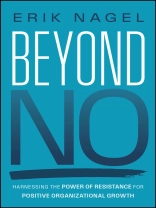Start viewing resistance as something beneficial instead of an inconvenience that must be eliminated
Beyond No: Harnessing the Power of Resistance for Organizational Growth is a thought-provoking exploration of the concept of resistance—something that is bound to arise within every organization in response to new projects, policies, or initiatives. Rather than seeing resistance as an inconvenience that needs to be eliminated, this book invites readers to take a new approach to different types of resistance, both hidden and obvious, and instead view resistance as a guiding light to discover objective differences, dissatisfaction, criticism of procedures, or different assessments or values.
This book contains a wealth of real stories from a wide variety of business leaders, detailing situations where resistance was encountered, solutions that were implemented, and their outcomes. Readers will also learn about:
- Shortcuts that lead to dead ends when managing resistance, including thinking “man does not want to change” and “one third is always against it anyways”
- Explanatory models behind resistance, including emotional events, attempts at domination, normative control, and expression of a damaged relationship
- Principles to productively manage resistance, including commitment, dignity, right to dissent, learning, and mindfulness
Beyond No earns a well-deserved spot on the bookshelves of all business leaders, executives, and managers seeking to achieve excellence in leadership through a thoughtful approach to resistance instead of relying on ineffective command-and-control tactics.
Tabela de Conteúdo
Introduction 1
Overview: Chapters 1–7 3
Chapter 1 Resistance: An Everyday Exception 5
1.1 Managers Tell Their Stories 7
1.2 The Word “Resistance” 8
1.3 Resistance: Burden or Resource? 11
1.4 Resistance Is Part of Everyday Life 13
1.5 The Winds of Resistance Blow from All Directions 14
1.6 The Zone of Uncertainty 16
Summary 18
Chapter 2 Overt Resistance 21
2.1 Resistance as an Emphatically Expressed Demand 22
2.2 Resistance as an Open and Endless Power Struggle 37
2.3 Resistance as Whistleblowing 48
2.4 Resistance as Organized Industrial Action 55
Summary 60
Chapter 3 Covert Resistance 61
3.1 Resistance as Humor 67
3.2 Resistance as Cynical Distancing 77
3.3 Resistance Between Submissive Overfulfillment and Subtle Refusal 83
3.4 Resistance as a Game of Rivalry 87
3.5 Resistance as Personal Rejection 91
3.6 Resistance as Willful Damage to the Organization 95
Summary 104
Chapter 4 Repressed Resistance 105
Summary 111
Chapter 5 Shortcut Assumptions That Lead to a Dead End 113
5.1 “People Are the Problem” 118
5.2 “One Third Is Always Against It Anyway” 127
5.3 “Where I Am, There Is Reason” 130
5.4 “Thinking at the Top, Doing at the Bottom” 137
5.5 “Management Must Fight the Inertia of the Organization” 141
5.6 Reflecting Instead of Taking Shortcuts 146
Summary 149
Chapter 6 What Is Behind Resistance: Explanatory Models 151
6.1 Resistance from the Perspective of Psychology 153
6.2 Resistance Arising Between People 158
6.3 Resistance to Control and Appropriation by the Organization 171
6.4 Resistance Due to Cultural Routines Within the Organization 180
Summary 189
Chapter 7 Leadership: The Art of Dealing Productively with Resistance 191
7.1 Four Leadership Principles 193
7.2 The Four Leadership Principles Illustrated by a Specific Case 203
7.3 Artfully Confronting Resistance 207
7.4 Artfully Evoking Resistance 217
7.5 Artfulness and Resistance: A Final Reflection 221
Summary 222
Sources 225
Literature 225
Web Links 231
Acknowledgments 233
About the Author 235
Index 237
Sobre o autor
ERIK NAGEL, Ph D, is a professor and Vice Director of the Lucerne School of Business and Co-Institute Director of the Institute for Management and Regional Economics IBR. He researches and teaches leadership, change management, resistance, cultural change, and organizational consulting.












